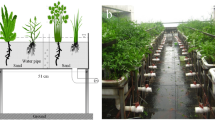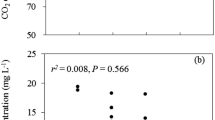Abstract
Plant species diversity could enhance plant productivity and pollutant removal efficiency in constructed wetlands (CWs). However, the potential importance of plant density for ecosystem functioning has largely been neglected. In this study, we conducted a factorial experiment in which three common plant species were planted in a gradient of species richness (one, two, and three) and seven species compositions at two densities (six and twelve individuals per microcosm). Plant total biomass and total organic carbon (TOC) and total inorganic nitrogen (TIN) removal efficiency were measured to explore the effect of plant species diversity and density on the ecosystem functioning of CWs. Results showed that (1) plant species richness had no significant effect on plant total biomass and TOC and TIN removal efficiency under high and low plant density. (2) There were significant differences in TIN removal efficiency among seven species compositions under low plant density; especially, the presence of Canna indica reduced the TIN removal efficiency. In contrast, species composition and species identity had no significant effect on ecosystem functioning under high plant density. (3) High plant density increased plant total biomass of C. indica monocultures, and also enhanced TIN removal efficiency in mixtures of two species. These results indicated C. indica alone may not be an ideal species for enhancing pollutant removal in constructed wetlands but planting at high density could mitigate its negative effect on ecosystem functioning.



Similar content being viewed by others
References
Abalos, D., Deyn, G. B., Kuyper, T. W., & van Groenigen, J. W. (2014). Plant species identity surpasses species richness as a key driver of N2O emissions from grassland. Global Change Biology, 20, 265–275.
Brix, H. (1994). Functions of macrophytes in constructed wetlands. Water Sciences Technology, 29, 71–78.
Caselles-Osorio, A., & García, J. (2006). Performance of experimental horizontal subsurface flow constructed wetlands fed with dissolved or particulate organic matter. Water Research, 40, 3603–3611.
Chen, Y., Wen, Y., Cheng, J., Xue, C. H., & Zhou, Q. (2011). Effects of dissolved oxygen on extracellular enzymes activities and transformation of carbon sources from plant biomass: implications for denitrification in constructed wetlands. Bioresource Technology, 102, 2433–2440.
Clescerl, L. S., Greenberg, A. E., & Eaton, A. D. (1999). Standard method for the examination of water and wastewater. American Washington: American Public Health Association.
Conley, D. J., Paerl, H. W., Howarth, R. W., Boesch, D. F., Seitzinger, S. P., & Havens, K. E. (2009). Controlling eutrophication: nitrogen and phosphorus. Science, 323, 1014–1015.
Engelhardt, K. A. M., & Ritchie, M. E. (2002). The effect of aquatic plant species richness on wetland ecosystem processes. Ecology, 83, 2911–2914.
Faulwetter, J. L., Gagnon, V., Sundberg, C., Chazarenc, F., Burr, M. D., Brisson, J., et al. (2009). Microbial processes influencing performance of treatment wetlands: a review. Ecological Engineering, 35, 987–1004.
Fraser, L. H., Carty, S. M., & Steer, D. (2004). A test of four plant species to reduce total nitrogen and total phosphorus from soil leachate in subsurface wetland microcosms. Bioresource Technology, 94, 185–192.
Galloway, J. N., Townsend, A. R., Erisman, J. W., Bekunda, M., Cai, Z. C., Freney, J. R., et al. (2008). Transformation of the nitrogen cycle: recent trends, questions, and potential solutions. Science, 320, 889–892.
Ge, Y., Han, W. J., Huang, C. C., Wang, H., Liu, D., Chang, S. X., et al. (2015). Positive effects of plant diversity on nitrogen removal in microcosms of constructed wetlands with high ammonium loading. Ecological Engineering, 82, 614–623.
Geng Y., Ge Y., Luo B., Chen Z.X., Min Y., Schmid B., et al. (2019) Plant diversity increases N removal in constructed wetlands when multiple rather than single N processes are considered. Ecological Applications, e01965.
Gu, B. J., Leach, A. M., Ma, L., Galloway, J. M., Chang, S. X., Ge, Y., et al. (2013). Nitrogen footprint in China: food, energy, and nonfood goods. Environmental Science and Technology, 47, 9217–9224.
Han, W. J., Chang, J., Fan, X., Du, Y. Y., Chang, S. X., et al. (2016). Plant species diversity impacts nitrogen removal and nitrous oxide emissions as much as carbon addition in constructed wetland microcosms. Ecological Engineering, 93, 144–151.
Han, W. J., Ge, Y., Ren, Y., Luo, B., Du, Y. Y., Chang, J., et al. (2018). Removal of metals and their pools in plant in response to plant diversity in microcosms of floating constructed wetlands. Ecological Engineering, 113, 65–73.
Han, W. J., Luo, G. Y., Luo, B., Yu, C. C., Wang, H., Chang, J., et al. (2019). Effects of plant diversity on greenhouse gas emissions in microcosms simulating vertical constructed wetlands with high ammonium loading. Journal of Environmental Sciences, 77, 229–237.
Harper, J. L. (1977). Population biology of plants. New York: Academic Press.
Hartmann, A., Schmid, M., Tuinen, D. V., & Berg, G. (2009). Plant-driven selection of microbes. Plant and Soil, 321, 235–257.
He, J. S., Wolfe-Bellin, K. S., Schmid, B., & Bazzaz, F. A. (2005). Density may alter diversity–productivity relationships in experimental plant communities. Basic and Applied Ecology, 6, 505–517.
Hecht, V. L., Temperton, V. M., Nagel, K. A., Pude, R. R., & Postma, J. A. (2019). Plant density modifies root system architecture in spring barley (Hordeum vulgare L.) through a change in nodal root number. Plant and Soil, 439, 179–200.
Hoagland, D. R., & Arnon, D. J. (1950). The water culture method for growing plants without soil. California Agriculture, 347, 1–32.
Jaddhav, R. S., & Buchberger, S. G. (1995). Effects of vegetation on flow through free water surface wetlands. Ecological Engineering, 5, 481–496.
Li, A., Niu, K. C., & Du, G. Z. (2011). Resource availability, species composition and sown density effects on productivity of experimental plant communities. Plant and Soil, 344, 177–186.
Liu, D., Wu, X., Chang, J., Gu, B. J., Min, Y., Ge, Y., et al. (2012). Constructed wetlands as biofuel production systems. Nature Climate Change, 2, 190–194.
Luo, B., Du, Y. Y., Han, W. J., Geng, Y., Wang, Q., Duan, Y. Y., et al. (2020). Reduce health damage cost of greenhouse gas and ammonia emissions by assembling plant diversity in floating constructed wetlands treating wastewater. Journal of Cleaner Production, 244, 118927.
Polley, H. W., Wilsey, B. J., & Derner, J. D. (2010). Do species evenness and plant density influence the magnitude of selection and complementarity effects in annual plant species mixtures? Ecology Letters, 6, 248–256.
R Core Team (2017) R: A Language and Environment for Statistical Computing. Vienna, Austria: R Foundation for Statistical Computing. https://www.R-project.org/ (30 November 2017, date last accessed).
Saeed, T., & Sun, G. (2012). A review on nitrogen and organics removal mechanisms in subsurface flow constructed wetlands: dependency on environmental parameters, operating conditions and supporting media. Journal of Environment Management, 112, 429–448.
Stachova, T., Fibich, P., & Leps, J. (2013). Plant density affects measures of biodiversity effects. Journal of Plant Ecology, 6, 1–11.
Stottmeister, U., Wiessner, A., Kuschk, P., Kappelmeyer, U., Kaestner, M., et al. (2003). Effects of plants and microorganisms in constructed wetlands for wastewater treatment. Biotechnology Advance, 22, 93–117.
Tilman, D., Isbell, F., & Cowles, M. J. (2014). Biodiversity and ecosystem functioning. Annual Review of Ecology and Systematics, 45, 471–493.
van der Plas, F. (2019). Biodiversity and ecosystem functioning in naturally assembled communities. Biological Reviews, 94, 1220–1245.
Vymazal, J. (2007). Removal of nutrients in various types of constructed wetlands. Science of Total Environment, 380, 48–65.
Vymazal, J. (2011). Plants used in constructed wetlands with horizontal subsurface flow: a review. Hydrobiologia, 674, 133–156.
Vymazal, J. (2013). Emergent plants used in free water surface constructed wetlands: a review. Ecological Engineering, 61, 582–592.
Vymazal, J. (2014). Constructed wetlands for treatment of industrial wastewaters: a review. Ecological Engineering, 73, 724–751.
Wei, X., Martijn, B. T., & Frank, B. (2018). Density-dependency and plant-soil feedback: former plant abundance influences competitive interactions between two grassland plant species through plant-soil feedbacks. Plant and Soil, 428, 441–452.
Weiner, J., Stoll, P., & Muller-Landau, H. (2001). The effects of density, spatial pattern and competitive symmetry on size variation in simulated plant populations. The American Naturalist, 158, 438–450.
Wu, J., Zhang, J., Jia, W. L., Xie, H. J., Gu, R. R., Li, C., et al. (2009). Impact of COD/N ratio on nitrous oxide emission from microcosm wetlands and their performance in removing nitrogen from wastewater. Bioresource Technology, 100, 2910–2917.
Funding
This work was funded by the National Natural Science Foundation of China (31901213) and the Natural Science Foundation of Zhejiang Province (LQ18C030001).
Author information
Authors and Affiliations
Corresponding author
Additional information
Publisher’s Note
Springer Nature remains neutral with regard to jurisdictional claims in published maps and institutional affiliations.
Supplementary information
ESM 1
(DOCX 14 kb)
Rights and permissions
About this article
Cite this article
Han, W., Sheng, X., Shao, J. et al. Effects of Plant Diversity and Plant Density on Ecosystem Functions in Floating Constructed Wetlands. Water Air Soil Pollut 231, 544 (2020). https://doi.org/10.1007/s11270-020-04913-3
Received:
Accepted:
Published:
DOI: https://doi.org/10.1007/s11270-020-04913-3




